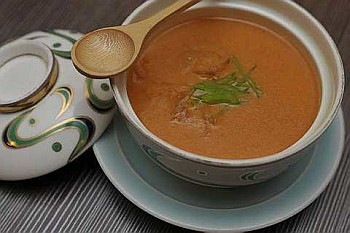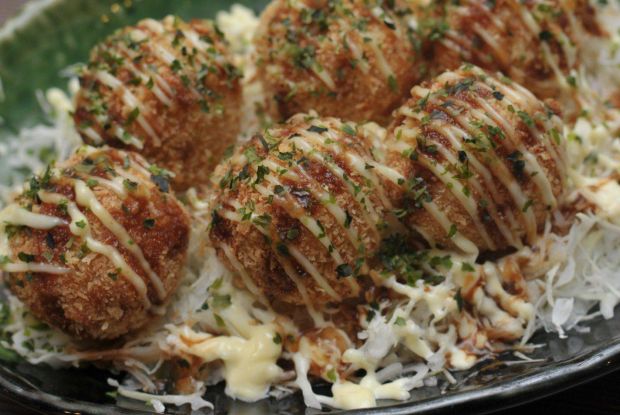Starting life anew as a restaurateur, Chef Ricky Kamiishi is determined to carve a niche of his own with Riki-ya.
RIKI-YA JAPANESE RESTAURANT
Unit P2-01
2nd Floor, Podium Block
Menara Keck Seng
203, Jalan Bukit Bintang
Kuala Lumpur
Tel/Fax: (03) 2143 3336
Menu prices are subject to 10% service charge.
Grilled chicken skin that tastes like smoked bacon, a fresh take on Osaka’s iconic squid ball (takoyaki) and new twists to the classic sushi – these are some of the culinary surprises that await diners at Riki-ya, a Japanese restaurant run and owned by Chef Ricky Kamiishi.
After bowing out as the executive Japanese chef at a five-star hotel in March this year, Kamiishi is starting afresh as a restaurateur. His 140-seat restaurant Riki-ya occupies what used to be Tykoh Inagiku, an established but low-key outlet with its own following of Japanese expats and white collar customers.
The outlet’s clean lines and wood-accentuated interior is sparsely decorated but spacious enough with four private dining rooms and separate teppanyaki, sushi and robatayaki counters. Naturally perennial delicacies from those three sections dominate the menu but keep your eyes peeled for the chef’s signature dishes like Tako Yaki Korokke or Deep-fried Octopus Balls (RM20+).
Kamiishi’s version of the octopus ball, a popular Osaka yatai (street food stall) speciality, is a tribute to the city where he first started working. Instead of sticking with the usual egg and flour batter, the chef uses mashed potato filled with chewy octopus pieces in the centre.
Crusted with breadcrumbs on the outside, the golf ball-sized orbs are deep-fried to crispy perfection and served with a drizzle of creamy mayonnaise, tangy ponzu (soy sauce with citrus juice) sauce and toppings of katsuobushi (dried bonito shavings) and chopped parsley.
“I became a chef simply because I love to eat,” says Kamiishi, who started honing his skills in a culinary college at 19 before joining Nadaman, one of Japan’s most respected restaurant groups, upon graduation.
“I was based at the Osaka outlet,” he explains.
Kamiishi was also part of the pioneer team who opened the Shangri-La Kuala Lumpur’s Nadaman back in 1991. After that four-year stint, he returned to Osaka. He then worked in Singapore before his friend – the owner of Tykoh Inagiku – lured him back here.

The Fukahire Chawanmushi contains crab roe, crab meat sauce, strands of shark’s fin, slices of shiitake and prawn.
Now that he is charting his own course, Kamiishi is pragmatic enough to know that customers who patronise Riki-ya are of a different breed from those he used to serve at his last place. Consequently, he shrewdly tempts them with affordable set lunches and reasonably priced specialities. However, those with deeper pockets should have no cause for complaint because they can always go for the prime cuts of Wagyu and other esoteric delights that are part and parcel of Riki-ya’s menu.
Alternatively, you may opt to let the chef surprise you with the freshest, choicest morsels in season by opting for the Omakase menu (chef’s selection from RM200+ onwards per person). But fret not. You can dine equally well for less, starting with the Fukahire Chawanmushi (RM24+).
Kamiishi bestows a luxurious touch to this typical Japanese dish by adding thick crab roe, crab meat sauce and strands of shark’s fin on top. Embedded inside the silky smooth egg custard are slices of shiitake and prawn, which further amplify the egg custard’s delicate nuance.
“It’s inspired by the Chinese banquet speciality of shark’s fin soup,” says Kamiishi.
The chef also makes an impression on the Edomae Nigiri Sushi (RM85+) platter, a creation that harks back to the classic seafood-topped, hand-shaped vinegared rice balls that you’d find in old Tokyo.
“In those days, Edomae (as Tokyo was known then) sushi was prepared with mainly cooked items as there was no chiller to store fresh food. This particular offering is my take on this enduring speciality in which I use both raw and cooked seafood: tuna belly, tuna, salmon roe, squid, prawn, saba (vinegar and salt-cured mackerel with konbu seaweed topping), yellow tail and sea eel, and a makizushi roll with kanpyo (dried gourd strips).”
Personally, I’d return to Riki-ya just for the Robata Moriawase (RM38+). We actually mistook the skewer of delectably crispy, smoky tori kawa (grilled chicken skin with salt) for streaky bacon! The other grilled items – ginnan (ginkgo nuts), shiitake, tebasaki (chicken wing), sunagimo (gizzard), negima (chicken drumstick meat with scallion) and tsukune (minced chicken meat balls glazed with teriyaki sauce) were equally scrumptious.
After that unexpected high, we found it was a tad difficult coming back down to earth with just Macha or Green Tea Ice Cream (RM8+) for dessert. Perhaps a scoop of Goma (black sesame) or Yuzu (Japanese citrus) ice cream would be more helpful in sweetening the landing for you?

